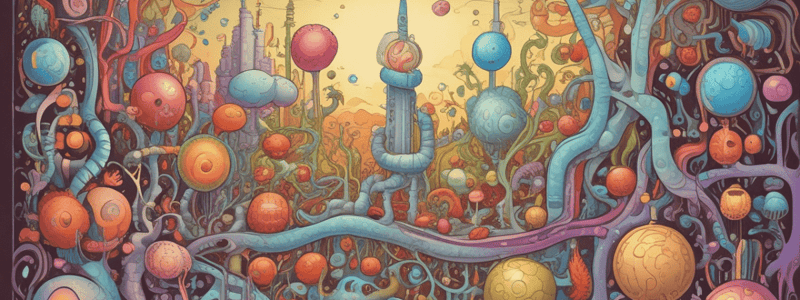Podcast
Questions and Answers
Where does the process of glycolysis occur?
Where does the process of glycolysis occur?
- Inner mitochondrial membrane
- Nuclear membrane
- Mitochondrial matrix
- Cytoplasm (correct)
What is the net gain of ATP in the process of glycolysis?
What is the net gain of ATP in the process of glycolysis?
- 2 ATP (correct)
- 1 ATP
- 3 ATP
- 4 ATP
What is the byproduct of the electron transport chain?
What is the byproduct of the electron transport chain?
- Water (correct)
- Glucose
- Pyruvate
- Carbon dioxide
How many NADH molecules are generated in the Krebs cycle per acetyl-CoA?
How many NADH molecules are generated in the Krebs cycle per acetyl-CoA?
What is the mechanism by which ATP is produced in the electron transport chain?
What is the mechanism by which ATP is produced in the electron transport chain?
What is the primary purpose of the Electron Transport Chain in cellular respiration?
What is the primary purpose of the Electron Transport Chain in cellular respiration?
How do the products of the Krebs Cycle contribute to the Electron Transport Chain?
How do the products of the Krebs Cycle contribute to the Electron Transport Chain?
What is the net energy yield of the Krebs Cycle per acetyl-CoA?
What is the net energy yield of the Krebs Cycle per acetyl-CoA?
What is the primary difference between the location of glycolysis and the Krebs Cycle?
What is the primary difference between the location of glycolysis and the Krebs Cycle?
What is the ultimate fate of the electrons passed through the Electron Transport Chain?
What is the ultimate fate of the electrons passed through the Electron Transport Chain?
Flashcards are hidden until you start studying
Study Notes
Glycolysis
- Occurs in the cytoplasm
- Converts glucose to pyruvate
- Produces a net gain of 2 ATP and 2 NADH molecules
Krebs Cycle (Citric Acid Cycle)
- Takes place in the mitochondrial matrix
- Each turn of the cycle converts acetyl-CoA into CO2
- Generates 3 NADH, 1 FADH2, and 1 ATP (or GTP) per acetyl-CoA
Electron Transport Chain (ETS)
- Located in the inner mitochondrial membrane
- Electrons from NADH and FADH2 are passed through the chain
- Ultimately reduces oxygen to water
- Produces a large amount of ATP via a proton gradient (chemiosmosis)
Studying That Suits You
Use AI to generate personalized quizzes and flashcards to suit your learning preferences.




